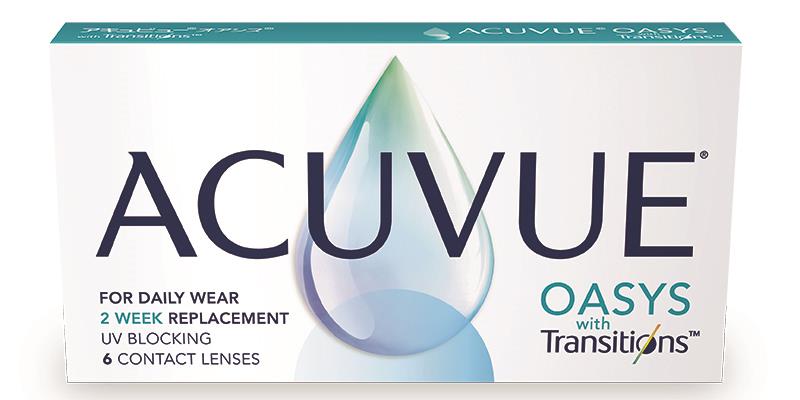Contact lenses have been getting more breathable, more comfortable and healthier for years but until now significant change in the way lenses interact with vision has been in short supply.
For the past 10 years, Johnson & Johnson Vision has been working with Transitions Optical Inc to develop a photochromic contact lens. The result is Acuvue Oasys with Transitions, a lens the firm said provides more benefits than simply relief from harsh light.
‘Describing it as a contact lens that is light or dark just doesn’t do it justice,’ said Dr Rachel Hiscox professional education and development manager at Johnson & Johnson Vision, UK and Ireland. She said the lens offers a range of benefits over and above constantly active UV protection, by seamlessly adapting to changing light levels throughout the day. She also said research shows those most interested in the innovation could go some way to growing the contact lens market.

‘We know that one of the things that really drives market growth is new innovation, so we are confident this lens will have a positive impact on both patients and the category. We are offering something completely new that goes beyond vision correction into dynamically filtering light,’ said Hiscox (pictured). She pointed to research showing that this type of product is appealing to a wide patient base and particularly the younger male audience, one perhaps into technology, gadgets or gaming. This opens up the prospect of addressing the female bias in contact lens wear and bringing down the age profile of the typical Transitions spectacle lens wearers.
‘We are taking contact lenses into another space,’ adds David Ruston, director global professional education and development at Johnson & Johnson Vision. ‘We want to bring new wearers into the market and grow the wearer population in the UK which has been stagnant for years. It’s a huge opportunity, it’s an entirely new category that we call light management.’
Ten-year journey

Johnson & Johnson Vision started its partnership with Transitions Optical more than 10 years ago, a time when Acuvue Oasys had already established itself as the leader in contact lens comfort. ‘It’s the number one reusable contact lens in the world,’ said Ruston (pictured) pointing to numerous studies, adding, ‘It’s a lens that’s never been beaten on comfort and is very much the industry benchmark.’
He said the driving factor behind the creation of Oasys with Transitions was consumer insights. In a study of 1,000 consumers in the US, nearly two thirds, 64%, said they were bothered by light on a daily basis while the vast majority admitted to compensating behaviours such as squinting, shielding their eyes or turning down the brightness on their computer. ‘The interesting thing is that while most consumers are affected by light, they don’t volunteer that to their eye care practitioner. Just one in three out of the 64% said they mention it, and only four in 10 are asked if light bothers them by their practitioner. So, not many practitioners ask and not many patients volunteer information about light issues but it’s a big problem that affects visual comfort. For individuals that wear contact lenses or want to wear them, it presents a huge opportunity.’ Part of the launch education will aim to alter attitudes toward light discomfort among patients and ECPs.
Hiscox explained that the lens itself feels just like the original Oasys lens. ‘If we look at the modulus, the wettability, the breathability, the invisible edge profile, it’s all the same as our regular Acuvue Oasys lens. Therefore, from a physical comfort perspective we should get the same results. What you’ll have now, is the added visual comfort from constant light management.’
The lens is currently being rolled out in the US and Canada in spherical powers. Fitting is similar to other Oasys lenses, as is handling, cleaning, powers and applying and removal. Some minor changes have been made to packaging to ensure the lenses are not exposed to too much light before the patient wears them. More information on the product will be revealed at the BCLA Conference in Manchester at the end of May and will become the firm’s premium reusable lens. ‘We expect to start having lens availability to UK eye care professionals halfway through the year,’ said Hiscox.
While the new lens’s performance equals that of the current Oasys and adds visual comfort, it also has additional potential health benefits, said Ruston, as the lens blocks more UV. This is borne out by the spectral transmission curve which is just one element in an array of findings, facts and insights Johnson & Johnson has amassed to back up the launch.
The Odyssey
The lens itself acts in a similar way to a photochromic spectacle lens, darkening on exposure to UV and high energy visible (HEV) light. But transferring the technology from these attributes to contact lenses proved to be a 10-year odyssey. ‘There are trillions of photochromic molecules embedded into the Senofilcon A matrix that make up the lens,’ said Ruston. ‘The challenge of taking a photochromic molecule and enabling it to be embedded homogeneously all the way through the lens matrix, uniformly from edge to edge, was a massive R&D effort.’
The photochromic molecules are permanently bound within the matrix and when photons of UV and HEV light hit one, a bond is broken, and it opens to absorb light. The more of these light wavelengths that hit the lens, the more of those bonds are opened and the darker it becomes.
Where the contact lens starts to differ from the spectacle lens is in its activation. A photochromic spectacle lens needs to be as clear as possible to look good but contact lenses do not need to be. Even indoors, Oasys with Transitions blocks up to 15% of visible light, while still appearing clear. Once outside, that absorption rises to 70% with the lens darkening in as little as 45 seconds. Fade back takes slightly longer but is quicker than a photochromic spectacle lens. This, explains Ruston, is due to the contact lens’s contact with the eye which maintains a consistent temperature, speeding the photochromic effect and allowing for a more seamless transition. It also means the contact lens has a more uniform performance and will work the same in any climate or country.’ We have some great claims of indoor performance and night driving that are related to that spectral absorption because the lens is always on,’ he said.
Hiscox is keen to stress that the lens’s performance is not just about light but about vision more widely, because of other effects such as chromatic contrast and photostress recovery. Research has also highlighted a number of situations in which Oasys with Transitions can do more than simply block sunlight. Research has shown that even in its relatively inactive state, it can reduce the haloes at night by 18%, and starbursts by 22%, on average, which could have an impact during night driving, for example.
From a wearer’s point of view, the light management is imperceptible because the transition is so gradual. ‘I think you would only notice it in the same way that you would if you took off a pair of Transitions spectacles,’ said Hiscox. It’s always active. Even if you were indoors with no UV exposure, there would still be some activation because of the chemical balance between the open and the closed bonds. Indoors this equilibrium sits between 6% and 15%.’

New packs will protect the lens from light
Another big issue J&J Vision wrestled with in the development of the lens was the cosmesis of the lens. If all HEV were blocked, the lens would appear yellow which wouldn’t look appealing. About half the HEV light is blocked, meaning the variable tint has a neutral grey colour which is hardly noticeable over the colour of the wearer’s iris. ‘A yellow lens wouldn’t look great, so we went through a lot of iterations and testing in the field to achieve the right cosmesis. It took a long time,’ said Ruston. He stated that in trials only 12% of people were bothered by the cosmetic appearance of the lenses and of them only 7% would be discouraged from wearing the lens.
It is ironic that for a company synonymous with UV and the UV blocking capabilities of its lenses, UV should be at the heart of the technical hurdles J&J faced when producing a photochromic contact lens. The process is all driven by HEV and UV which posed its own problems for the researchers when developing the adapted monomer and the manufacturing process. ‘This lens absorbs light and we cure our lenses with light, so we had to develop an entirely new manufacturing technique to manufacture these lenses,’ said Ruston. This gives an indication of the challenge and the time taken to create a product that does the job it is supposed to do but is still affordable to consumers and practical to make in the huge quantities needed for a global market. Johnson & Johnson Vision is now ready with an entirely new production line operating processes which make lenses from the Oasys monomer with a photochromic additive.
With the product ready for market in the US, Canada and shortly in the UK, we will have to find out if Acuvue Oasys with Transitions Light Intelligent Technology has the ability to create a new category for the contact lens business.
‘We see this as a lens for anybody, anywhere, any day, who is bothered by light,’ said Ruston. ‘We would like to ask practitioners to ask their patients’ one question: “Do you ever find yourself bothered by light?” if they answer is: “yes”, why wouldn’t you offer them a remarkable new product?’
